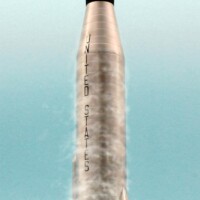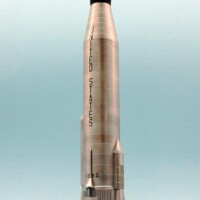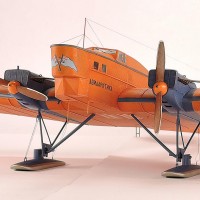"The Two Faces of the Atlas", Part II: John Glenn and Friendship 7 on Mercury Mission MA-6!
NASA's namesakes loved (and love) to be mythological and classical: an overview of the space flight programmes and spaceship names buzzes with gods and goddesses from classical Greek mythology. One god's name in particular stands out from this crowd: Mercury, the winged messenger of the deities, was made the patron saint of the first manned space flight programme. Another reference to the classics: seven selected, daring heroes, the "Mercury Seven", were to storm the skies and achieve the previously unthinkable!
About the Mercury space flight programme, October 1985 to May 1963
The "Mercury Seven" were selected from among the highly qualified test pilots of the four branches of the armed forces: Navy, Marines, Air Force and Army. The selection process began with the start of the Mercury programme in October 1958. By February 1959, the pool of 508 eligible pilots (225 Navy, 225 Air Force, 35 Army and 35 Marines) had already been narrowed down to 110 and on 9 April, the final selection of the seven Mercury pilots was presented at a press conference to great media attention. These were Lt. Commander Alan B. Shepard, Lieutenant Malcolm Scott Carpenter, and Lt. Commander Walter M. Schirra from the US Navy, while the Air Force was represented by Captain Virgil I. Grissom, Captain Donald K. Slayton and Captain Leroy Gordon Cooper. Lt. Colonel John H. Glenn was the only representative of the US Marines to complete the "Magnificent Seven".
The challenges faced by those responsible for the Mercury programme were indeed "heroic". New technical ground had to be broken in almost all areas and researched to such an extent that it was possible to dare to launch a human being into Earth orbit in front of the world public - and, if possible, to bring him back alive. The focus was therefore not so much on the development of the rocket propulsion system itself - experience had already been gained from the military use of large rockets in the early 1950s - but rather on the many unknown variables surrounding life support, radiation protection, rescue systems, the effects of weightlessness and, last but not least, the conditions for a successful return!
Interestingly, it was decided that each member of the "Mercury Seven" would specialise in one of these areas. At the same time, the team spirit was upheld and care was taken to make decisions together. The active role that the "Mercury Seven" had to play in the course of the programme is even reflected in the design of the newly developed space capsule: the astronauts flying in orbit were not to be mere passengers, but were to be able to actively control the flight: a total of 55 switches and 35 levers (as well as 30 safety devices) were used to actively influence the flight of the Mercury capsule during the orbits around the Earth. However, precautions had also been taken to take over the flight control, including the landing, remotely from the ground station should the astronaut fail.
It is fascinating to read in the literature how the design of the Mercury capsule developed from the initial considerations to its finalisation. After all, the capsule was travelling in Earth orbit at a speed of over 28,000 km/h and therefore had to re-enter the Earth's atmosphere! The enormous amount of energy released in the process would cause the front end of the capsule to glow, which made it necessary to design a completely new type of heat shield. This heat shield would lead to extremely dramatic minutes during John Glenn's MA-6 mission, which was carried out with the Mercury-Atlas combination shown here. The development and construction of the 20 Mercury capsules delivered were undertaken by McDonnell Aircraft Corporation.
All manned Mercury capsules were given their own names, which the respective astronauts were allowed to choose. However, the number "7", which was intended to emphasise the community of the "Mercury Seven", was binding. From May 61 to May 62, the Mercury capsules "Freedom 7", "Liberty Bell 7", "Friendship 7", "Aurora 7", "Sigma 7" and "Faith 7" flew into Earth orbit.
While pioneering work was indeed necessary in the development of the capsule, the choice of launch vehicle was based on tried and tested technology: the choice fell on the high-thrust Redstone and Atlas rockets, which were already in use as ICBMs by the Army and Air Force. In fact, the 24 launches of the Mercury programme were carried out exclusively with Redstone and Atlas. You can find a brief outline of the history of this Convair-produced missile in my article on the SM-65 D Atlas ICBM if interested.
About the original: Mercury "Friendship 7"/ Atlas, Mercury MA-6
The model shown here represents the Mercury-Atlas combination of the MA-6 mission, the first US orbital flight, which was carried out on 20 February 1962. After two previous successful manned suborbital flights with Grissom and Shepard, John Glenn was to set off on the first space flight by an American on 20 February 1962. Three orbits of the earth with an apogee of 265 kilometres and a perigee of 159 kilometres were planned, John Glenn would reach a speed of 28,205 km/h and cover a distance of 121,794 kilometres during the five-hour space flight.
After weeks of preparation, the launch and insertion into the planned orbit went smoothly. However, during the second orbit, the ground station received a signal from the capsule that the heat shield was no longer correctly attached to the capsule. If this was indeed the case, the capsule and John Glenn would inevitably burn up on re-entry. After dramatic minutes and heated discussion, the ground station made two decisions: firstly, John Glenn would not be informed of the threatening situation, and secondly, the three braking rockets mounted in front of the heat shield would not be jettisoned after the deceleration process. The hope was that their attachments would stabilise the supposedly loose heat shield.
The re-entry into the Earth's atmosphere and the landing were indeed dramatic. However, this had nothing to do with the heat shield, as it was firmly attached to the capsule - a faulty switch had, as it later turned out, caused a false alarm. However, a strong vibration built up during re-entry, causing the capsule to swing wildly. After all the fuel for the attitude control had been used up, Glenn was unable to do anything about the oscillation. The capsule swung up to 10 degrees relative to the direction of flight, which forced Glenn to decide to deploy the brake parachute earlier than calculated. Shortly before he was able to initiate this potentially dangerous measure himself, the parachute was activated prematurely by the automatic landing system, which stabilised the rest of the flight. After a flight time of 4 hours 55 minutes, Glenn splashed down about 60 kilometres from the planned destination, as the braking rockets that had not been dropped had changed the flight path. Glenn and "Friendship 7" were successfully recovered soon afterwards by the destroyer USS Noah.
John Glenn's charismatic and engaging nature ensured that he not only earned the fame and public reputation that was already associated with being part of the "Mercury Seven", but also remained a universally recognised public and political figure even after his time as a test pilot and astronaut. As a senator for Ohio, he was associated with the Democratic Party for many years. He attempted to run for president for the Democrats in 1984, but failed. In October 1998, he launched into Earth orbit again on the STS-95 space shuttle mission as the oldest astronaut in the world at the time. On 7 November, he returned from Earth orbit for the second time in his life, this time not after three orbits, but after -134!
To kit and model
The Australian manufacturer, Model Horizons, has certainly put high quality in the attractively designed box. The plastic parts are cleanly moulded and accurately textured, and the included etched parts can be used to further enhance the attractive level of detail.
In keeping with the nature of the original , the construction of the launcher and Mercury capsule is not overly complicated, but the manufacturer's interest in guiding the modeller to the correct details of the selected Mercury-Atlas versions is nevertheless evident in the detailed instructions.
As with the construction of the first Atlas rocket, I really enjoyed the entertaining building process, and it was particularly entertaining for me to try out the design of the numerous metal shades of the rocket body using Alclad metal paints. If you would like to find out more or are interested in a comparison with a military ICBM Atlas, I would like to refer you to my first article on building an Altlas from Model Horizon.



















Excellent work on the model (as usual) and good history @rosachsenhofer.
A very good history of the more personal aspects of the Mercury program is still Tom Wolfe's "The Right Stuff."
A couple of interesting asides for fans of the topic:
During World War II, Charles A. Lindbergh visited the Marine squadron in the Central Pacific John Glenn was a member of and taught them how to get better performance (range, lifting ability) from their planes. Lindbergh flew several missions with the Marines to demonstrate what he was teaching, and Glenn was his wingman on all of them. The two Lone Eagles, flying together.
For those who ever watched the old "Steve Canyon" TV series, Gordo Cooper was flying the F-102 in the opening sequence, and created the camera pod they used for aerial filming.
Hello Tom, I would like to thank you for your comment for two reasons: firstly, I am delighted to receive recognition from such an authoritative source, and secondly, the wealth of your knowledge and your ability to combine facts to create new stories is marvellous.
Glenn and Lindbergh in action together - I would never have thought of it!
Fantastic job and great history, Roland!
Thank you my friend!
Well done, Roland! @rosachsenhofer
I am hoping to build my Horizon Redstone and Mercury kits in the coming year. Your builds are great inspiration.
Makes me proud, thank you!
Excellent write up and model build (@rosachsenhofer).
Thank you John!
🙂 ... Greetings ... 🙂 :
Nicely amusing and very pleasurable reading post Roland.
Thank you for your words!
Great result and article, Roland @rosachsenhofer
Thank you indeed!
Beautiful model, and a great history lesson. Just thinking of the lives all those men lived between being war veterans, test pilots, astronauts, and beyond is truly amazing! Very brave men. Thanks for the insight into the the Mercury space program Roland, it was very interesting.
Thank you for your words - you're right, what biographies!
Thanks for the excellent model and history.
Very sppreciated-thank you!
What they said ,nicely done looks great.
Thank you Robert!
Excellent results, congratulations!
Thank you Marcello!